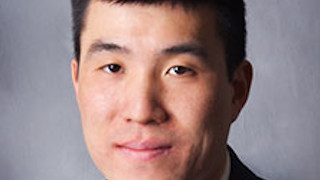7 Questions with a COVID-19 Researcher
Wednesday, April 8, 2020

An Introduction to the Study:
The study models the COVID-19 virus spread, exposures, and infections based on its
demographic characteristics and travel paths. Multivariate, multilevel, and multistage
models are built for surveillance and alerting. COVID-19 prevention and control experiences
from developing and developed countries are studied and summarized to identify risk
factors. An important goal of the study is to deeply mine the optimal model of effective
preventive strategies to prevent virus spreading and infection. Dynamic models will
be developed to track the development and migrations of infected individuals and track
the spreading channels among persons. Finally, the study develops mechanisms to systematically
identify individuals at risk during incubation period and tests the identification
and prevention strategies using simulation techniques. Dr. Zhang believes that the
knowledge gained from this project will greatly benefit the prevention and tracking
of coronavirus spreading globally.
7 Questions with the COVID-19 Researcher:
1. Is there any information you can provide at this time regarding your examination of the virus spread, exposure and infections based on demographic characteristics and travel paths?
Zhang: Through the analysis of population migration paths and confirmed coronavirus infections before the Chinese Spring Festival, the study found that 73 percent of the coronavirus positive cases in China were likely caused by the transmissions from Wuhan and direct exposures, while the other 27 percent cases resulted from virus spreading within the cities.
2. Which developing and developed countries are you studying to help identify risk factors?
Zhang: The investigative team focuses on China and hotspot areas in China right now. Yet, the investigators also closely monitor the pandemic controls and preventions in countries with increasing infections and higher mortalities, such as Italy and Iran. In addition, the team started to summarize the successful strategies around the world in controlling infectious diseases such as Ebola and H1N1 flu.
3. Which Chinese communities, regions, or cities are you studying?
Zhang:
- Wuhan, as the first epicenter of coronavirus outbreak in China
- Cities with known epidemiological characteristics such as Beijing, Shanghai, Shenzhen (Guangdong Province) and Wenzhou (Zhejiang Province)
- Cities with high risk of migrated population such as Yiwu (Zhejiang Province), Qingtian (Zhejiang Province)
- Cities that are representative of broader China areas: Weifang (Shandong Province), Xiamen (Fujian Province), Kaifeng (Henan Province) and Kashi (Xinjiang).
4. Though the research project is still in progress, is there any information you can share about improving preventive strategies to avoid further spread globally?
Zhang:
- Early screening, early detection, early quarantine, and early treatment. Traveling and gatherings increase the chances of virus exposure and lead to virus spreading and interhost transmissions. Restrictions need to be imposed on public transportations, social interactions, and community activities. Blocking transmissions is an effective way for pandemic containment. Migration controlling and population isolation based on big data and informatics lessens the magnitude of virus spreading and infections.
- Risk stratification and customized strategies for different risk groups. Restrictive movements and health educations are for general public and asymptomatic individuals in the communities; tracking, self-quarantine, and timely screenings are for individuals with minor upper respiratory symptoms, suspected cases, and individuals with close contacts with confirmed cases; comprehensive treatments and rescue are for patients in inpatient care and ICUs.
- Balance between infection control and economic recovery. When the “safety point” is reached, for example, no new cases in a couple of consecutive weeks, the balance between infection control and economic development will become a hot topic. This study made recommendations on schedules and steps for employees and students returning to work and schools given the patterns of coronavirus spreading.
5. What are some of the simulation techniques involved in testing the identification and prevention strategies?
Zhang:
- Logistic predictive models are used to forecast the infection rates of coronavirus at various provinces and cities. Simulations based on logistic models and different precaution measures are performed to spotlight the trajectory of coronavirus positive patients
- Bayes estimations to predict the changes of new cases and cured cases in non-Hubei provinces in China
- Non-linear regression simulations to understand the variations of accumulative positive cases
6. The President of the United States has now extended the national period of social distancing through April 30. Given your modeling of the virus and its impact on China, Italy, and Iran and your understanding of its current status in the United States, should officials consider extending the restrictions beyond this 30-day period?
Zhang: The transmission of coronavirus changes quickly. The extension of social distancing policy really depends on many factors including but is not limited to the growth of confirmed positive cases, death toll, new positive cases, geographic distribution, measures of self-quarantine, and effectiveness treatment and/or prevention strategies. Staged policies are appropriate as the pandemic evolves.
7. As the virus continues to spread across the nation, some state and local governments have taken a stricter stance on social distancing, gatherings, and required self-quarantine for travelers than others. Should the federal government enact stricter guidelines to be enforced by each state instead of this individual state approach.
Zhang: Based on our study, technically, stricter guidelines and enforcements would help block the virus transmissions among individuals and communities. Health policy also considers the levels of infections, area variations, culture, tradition, resources, and healthcare access which varies across states. States and municipalities with higher numbers of positive cases and new cases require stricter guidelines and closer surveillance compared to other states and areas.
Ning (Jackie) Zhang, PhD, MD, MPH:
Ning (Jackie) Zhang, PhD, MD, MPH, is the Associate Dean for Academic Affairs and
Professor of Health Sciences and Administration in the School of Health and Medical
Sciences. He is an Adjunct Professor of Medical Sciences for Hackensack Meridian School
of Medicine at Seton Hall University. As a health services and policy researcher,
Dr. Zhang's research focuses on public health policy, pharmaceutical outcome research,
nurse staffing, clinical outcomes, quality of care, long term care, disease management,
emergency medical services, clinical trial, health informatics, and big data analytics.
He has served as PIs and Co-PIs on a number of federal (NIH and VA), state and local
government, foundation and industrial research grants. Dr. Zhang is currently a Fellow
of the Gerontological Society of America, the Editor-in-Chief of the International Journal of Computational Medicine and Healthcare and an NIH and VA grant panel reviewer.
Categories: Health and Medicine, Research





